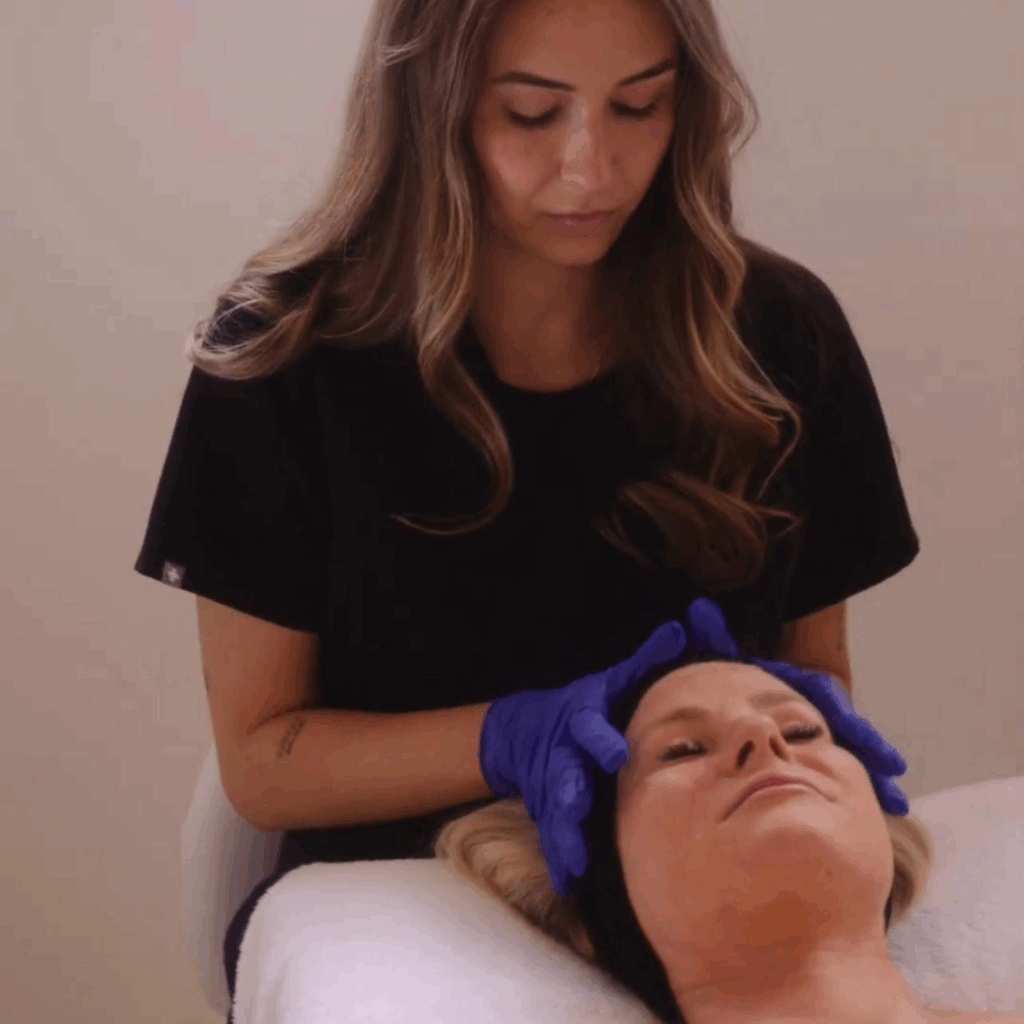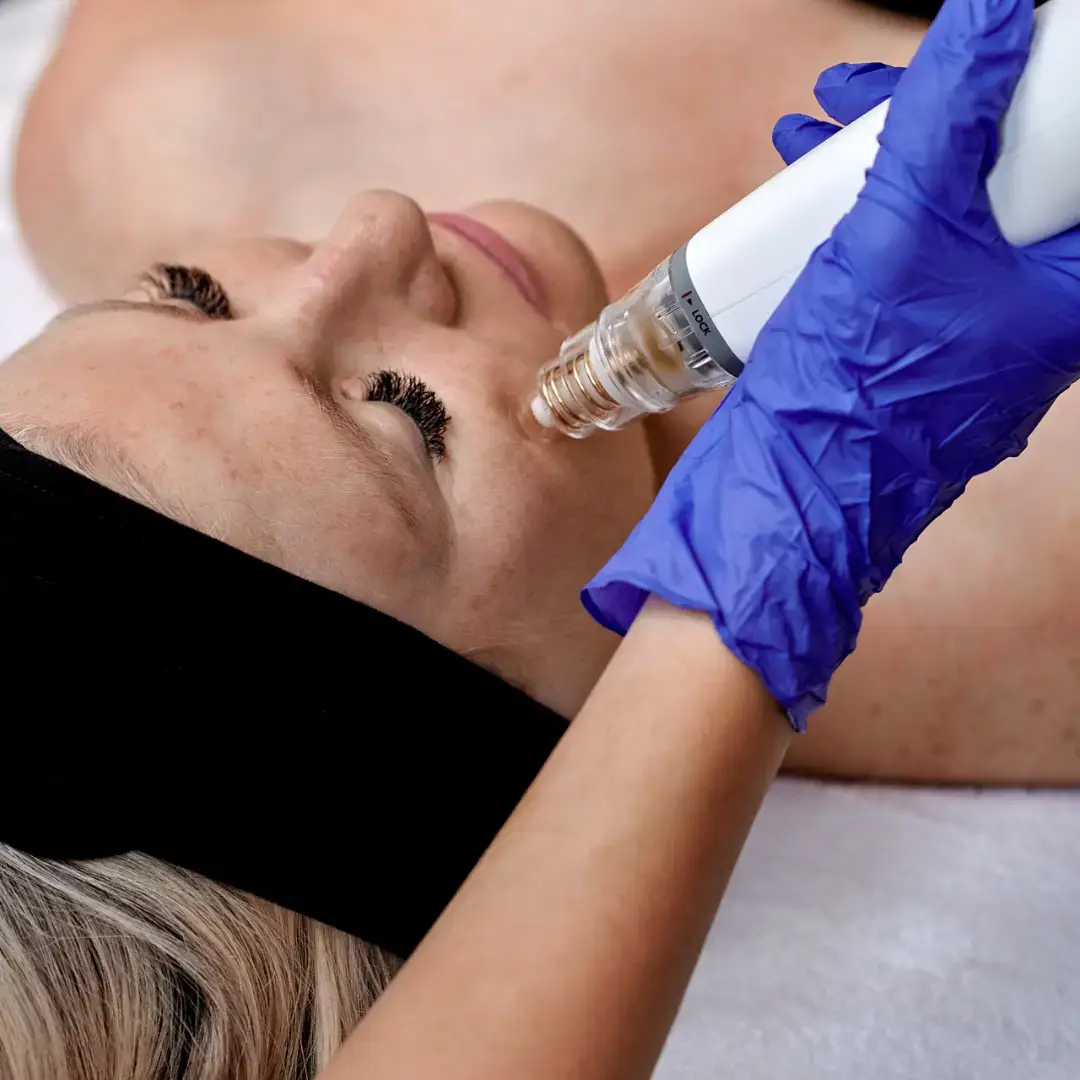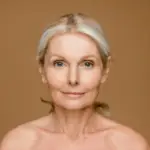What is sagging and loosening of the face?
The face is a reflection of our age and health. Over time, skin aging manifests itself in sagging facial skin and loss of elasticity. These changes can affect different areas of the face, including the forehead, eyelids, cheeks, oval, neck, eye contour, nasolabial folds and décolleté.
The unique Clinique M approach
At Clinique M, we combine medical expertise with cutting-edge technologies to treat skin laxity safely and naturally. Our physicians and specialists personalize each treatment plan to restore firmness, elasticity, and facial definition — while preserving your natural features and harmony.

Specific causes of sagging skin
Natural aging
With age, collagen and elastin production declines, leading to a loss of skin elasticity.
Bone changes
The reduction in facial bone mass with age can contribute to skin sagging. Facial bones, especially those of the eye socket, jaw and cheekbones, can shrink over time, altering the structure of the face.
Muscular atrophy
Facial muscles can weaken and atrophy with age, which also contributes to sagging skin.
Sun exposure
UV rays can accelerate the aging process by damaging the skin’s collagen and elastin.
Smoking
Smoking reduces blood circulation to the skin, which can accelerate the aging process.
Hormonal changes
Hormonal changes, particularly during menopause, can affect skin elasticity.
Genetic factors
Genetics can play a role in how the skin ages.
Areas concerned
The lion’s wrinkle
Appears between the eyebrows, as a result of the habit of frowning at them. This wrinkle can give a severe appearance to the face.
Horizontal wrinkles at the root of the nose
These appear from a certain age and are associated with sagging forehead skin and hyperaction of the orbicularis muscle.
Crow’s feet wrinkles
These form around the eyes and are often associated with skin aging.
Bitter lines
These create a depression triangle between the lower lip, the labial commissure and the mandibular region. These wrinkles appear around age 50 and give the face a sad, worried, frozen look.
Valley of tears
This refers to the mediojugal wrinkle, i.e. the hollow between the wings of the nose and the cheekbone area. This area is very fragile and wrinkles easily. Sagging in this area appears with age, marking the face with a diagonal hollow on the cheek, starting from the corner of the inner eye. This sagging gradually alters the harmony of the face, giving a marked, sad, even aged look to the eyes.
Lip wrinkles
Appear around the mouth and are often associated with loss of lip volume.
Chin wrinkles
Appear on the chin and are often associated with sagging skin.
Neck and décolleté wrinkles
Appear on the neck and décolleté and are often associated with aging skin.
Dehydration lines
These are caused by skin dehydration and often appear around the eyes and mouth.
Aesthetic medicine treatments
At Clinique M, we offer non-surgical, safe, and personalized solutions to correct signs of aging, restore facial volume, and improve skin quality. Through advanced technologies and injectable treatments, we help our patients achieve a more balanced, natural, and radiant appearance.

Non-surgical treatments
Free consultation
Hyaluronic acid injections
These injections of filling agents or fillers are used to fill wrinkles, restore volume and deeply hydrate the skin.
Popular products:
Restylane: Ideal for treating moderate to severe wrinkles, redefining facial contours and enhancing lip volume.
Botox (botulinum toxin)
Botox is used to reduce expression lines by temporarily paralyzing the underlying muscles.
Target areas:
- Forehead
- Frown lines (between eyebrows)
- Crow’s feet (outer corners of the eyes).
Potenza RF Microneedling
This technology combines microneedling and radiofrequency to stimulate deep skin regeneration. The ultra-fine needles create micro-perforations in the skin, allowing the radiofrequency energy to penetrate more effectively and trigger the production of collagen and elastin.
Results: Firmer skin, improved texture, reduced scars and enlarged pores, and a more even complexion.
Radiofrequency
This technique uses radio waves to heat the deep layers of the skin, stimulating collagen production.
Results: Tighter skin, improved texture and reduced wrinkles.
Aesthetic laser
Laser technology targets the superficial and/or deeper layers of the skin to stimulate cell renewal and collagen production.
Types of lasers:
Fractional Laser: Perfect for smoothing the skin, reducing scars and fine lines, and evening out the complexion through deep skin regeneration.
CO2 Laser: Ideal for treating deep wrinkles, scars, and improving overall skin texture.
Fraxel Laser: Used to treat wrinkles, pigmentation spots, and enhance skin texture.
Volumizing injections:
Surgical treatments
ChatGPT a dit :
In some cases, facial sagging can also be corrected through surgical procedures. These options include a facelift, blepharoplasty (eyelid surgery), and facial liposuction, all performed by specialized surgeons.

Surgical treatments
Free consultation
Facelift
A surgical procedure to tighten facial skin for a more youthful appearance.
Blepharoplasty
Eyelid surgery to correct sagging upper eyelids and eliminate bags under the eyes.
Facial liposuction
To remove unwanted fat deposits, particularly around the neck and jawline.
Products used in treatments
Serums: Contain active ingredients such as hyaluronic acid, vitamin C and retinol.
Creams: Moisturize, protect against UV rays and stimulate collagen production.
Products like Retin-A are effective against aging.
Masks: Offer intense hydration, a lifting effect and tighten pores.
Conclusion
Facial sagging is a natural phenomenon that occurs over time. Fortunately, thanks to advances in aesthetic medicine, it is now possible to counteract these signs of aging. At MRockland, we have a wide range of non-invasive treatments to suit every need. Whether you opt for filler injections, volumizing injections, laser treatments or other innovative techniques, our team is dedicated to giving your face a rejuvenated and revitalized appearance. It’s essential to consult our specialists to determine the best approach for your needs and expectations.
FAQ
Sagging refers to the loss of volume, while loosening refers to the loss of skin elasticity.
Several factors contribute to sagging facial skin. With age, the production of collagen and elastin, essential for keeping skin firm, diminishes. In addition, loss of facial fat, prolonged sun exposure, smoking, hormonal variations and genetics can also play a role in sagging skin.
There are several ways to combat facial sagging:
Non-surgical treatments such as hyaluronic acid injections, Botox, radiofrequency and aesthetic lasers.
Surgical treatments such as facelifts.
Adopt a proper skin care routine, including the use of anti-aging creams.
Protect skin from the sun by using sunscreen.
Eat a balanced diet and drink enough water.
Avoid smoking and excessive alcohol consumption.
Jowls are often the result of loss of skin elasticity and gravity. To lift them :
Hyaluronic acid injections can help restore volume to the area.
A facelift or mini-facelift can be considered for longer-lasting results.
Radiofrequency and laser treatment can also help tighten the skin.
To redefine the oval of the face :
Tensor threads can be used for a lifting effect.
Hyaluronic acid injections can help restore volume and define the oval.
Radiofrequency and laser treatments can tighten the skin.
In more advanced cases, a facelift may be recommended.
That depends on the individual, but prevention can begin as early as your thirties.
Most non-surgical treatments are painless, and topical anesthetics can be used. Surgical treatments require anesthesia.
Hyaluronic acid results can last from 6 to 18 months, while Botox results generally last from 3 to 6 months.
Your transformation starts here
Do not hesitate to contact us for a personalized consultation and to begin your transformation.
* Results may vary from person to person. We present, to the best of our knowledge, an average of the results obtained. No guarantee is offered. Our goal is to properly evaluate your profile so that you can make an informed decision.
Get a free consultation*
Consultation without obligation
Thousands of satisfied clients have trusted our medical-aesthetic clinic for over 15 years.
Thousands of satisfied customers




A trusted medical-aesthetic clinic for over 15 years.
⭐️⭐️⭐️⭐️⭐️ — 4.9/5 on Google
Our commitment
Response within 24 hours
Personalized treatment
Contact Us
Phone
(438) 601-4718
Our Address
233 Av. Dunbar, Mont-Royal, QC H3P 2H4, Canada

